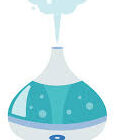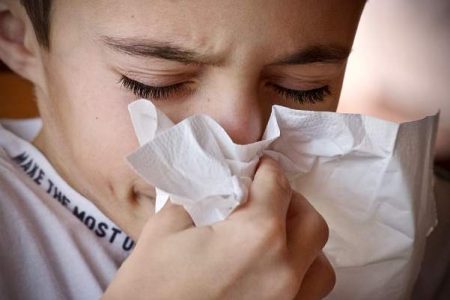Signs Your Humidifier Is Making You Sick with Humidifier Fever, Humidifier Lung & Others
What humidifier sickness symptoms do you need to watch out for? There is a good number of them.
A dirty humidifier can and will have serious repercussions for your health.
Relax though. You see, while a humidifier has its fair share of downsides, its benefits outweigh the disadvantages of staying in or sleeping in a dry room.
Humidifiers are built to enhance your indoor comfort. They do a great job of raising the humidity level in your indoor space.
However, if unchecked or used improperly, they can raise the humidity too much. Too high humidity is not good at all.
In this post, we are going to cover everything possible about how a humidifier could be causing you serious symptoms.
Can a cool mist humidifier make you sick?
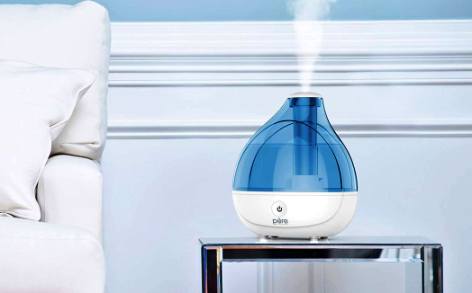
Yes, it can. It will do that in the following ways:
- Raising the humidity too much, such that it causes mold
- Dust mites thrive in high-humidity conditions
- It can spread bacteria and germs in the mist if you leave it dirty
Unlike their warm mist or evaporative units, which boil water and can kill mold and bacteria, cool mist units use cold water. Therefore, they are more likely to make you sick.
Some types of illnesses that you can experience with cool mist humidifiers include:
- Respiratory illnesses
- Colds, congestion, coughing, and others
- Itching skin, running eyes and nose
- A humidifier (unbelievably) can cause dehydration
Although these diseases can affect healthy people, they are more likely to affect people with weak immunity. They can affect people with allergies, asthma, and others.
A humidifier won’t always make you sick. Only dirty and unkempt units can cause sickness. However, high humidity makes you feel awful, so don’t use the humidifier unless it is necessary.
Symptoms of humidifier sickness
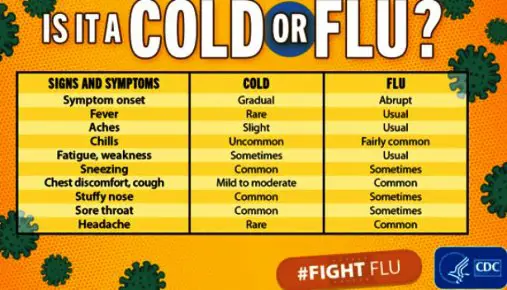
Please note that these symptoms are common with other diseases too. You need to rule out other causes first before you can blame the humidifier in your bedroom, office, or living room.
The indications for humidifier-caused sickness are as follows:
1. Flu-like Symptoms: Can humidifiers cause a cold?
Are you getting flu-like symptoms such as shortness of breath? If you haven’t cleaned your humidifier, you should check it out.
Such symptoms include high temperature, coughing, chills, and headaches.
Even if you know other things caused your flu, if you have not cleaned this appliance, clean it. You can use a clean humidifier even if you are down with another illness.
Another thing is that a humidifier causes a sore throat. Mostly, it helps with a sore throat because the moist air is soothing as it goes over the inflamed throat tissue.
However, if you are exposed to viruses, fungi, and other microbes that grow in the damp environment of the humidifier, you could develop a sore throat.
2. Allergy flare-ups
Fungi, mold spores, and white dust can cause allergic reactions. Therefore, if your allergies are triggered, check the humidifier. If it hasn’t been cleaned for a while, then it could be producing these allergens.
If you experience humidifier causing chest tightness, you could be getting an allergy flare-up. You need to turn it off for some time.
3. Sinus blockage
Sinus infections cause sinus blockage because of breathing in pseudomonas bacterium from the humidifying tank.
If you get sinus blockage and this appliance is running, try moving away or turning it off. If the blockage disappears, it is time to give the humidifier a thorough cleaning or replace it.
4. Lung infections

Can a humidifier make your chest hurt? If you have asthma, a humidifier can make it worse. It can cause the airways to inflame, which would cause chest tightness in return.
If you inhale white dust, you could end up with lung infections. White dust comprises mineral deposits emitted by humidifiers if you put tap water in the reservoir.
To prevent this, you should only use distilled or demineralized water.
One such lung infection is Legionnaires disease. It is a type of pneumonia caused by legionella pneumophila, which is found in static water storage.
Its signs include high temperature, headache, coughing, mental confusion, diarrhea, and muscle aches.
5. Humidifier Fever/Lung
Humidifier fever/lung is one of the bacteria in illnesses. You can get it if you inhale vapors that have bacteria.
So, if you don’t clean your unit, you will end up with colonized bacteria. When emitted with the mist, they cause fever, which is a viral lung inflammation.
Symptoms include fever, body aches, coughs, chills, inflammation of the lungs, shortness of breath, and malaise.
If you notice these symptoms, clean or remove the humidifier. If you don’t, the illness can become chronic with symptoms such as loss of appetite, lung disease, lung scarring, weight loss, and respiratory infections.
6. Asthma attacks
Ideally, your humidifying appliance increases moisture and eases breathing, especially for people who have allergies, asthma, and children.
However, when the unit releases dirty mist, which has fungi, bacteria, and mold, it can trigger an asthmatic attack.
Therefore, if you are asthmatic and using a humidifier, you were right for a while, but if you start getting asthmatic attacks, check the unit.
It could be dirty and produce the fungi and mold that are triggering the attack.
7. Coughs and Colds
This is one of the dangers of humidifiers.
If you are catching coughs and colds, it could be your humidifier spreading them. A dirty humidifier will create a good environment for bacteria to grow.

8. Humidifier causing shortness of breath
Unknown to many people, this is another way that a humidifier can make you feel really sick. In addition, a humidifier causes chest tightness.
When the humidity level is high, the air becomes stuffy and hard to inhale. This can be quite hurtful, especially for people with low lung capacity, such as children.
If you have a cold, you are more likely to experience shortness of breath when the humidifier is running. Usually, healthy people might not experience this, but it is a concern.
The best thing is to maintain a good level of humidity because dry air can cause the same problem—shortness of breath!
Dry air can inflame the airways. Reducing their capacity to take in large volumes of air.
How a humidifier can make you sick
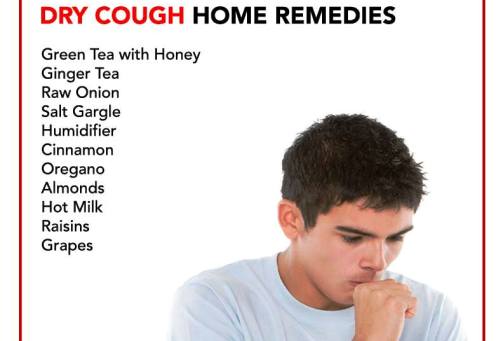
Now that we have seen the symptoms of humidifier sickness, we want to look at how these units can make you sick. Usually, they do this in the following two ways:
1. Too high humidity
In summer, the indoor humidity level should be 30 to 50 percent. For winter, set the humidity at 30 to 40 or 45 percent.
Indoor humidity, also called relative humidity, is like a double-edged sword. If it is too low, it has ill health effects.
If you keep it too high, it has ill effects too. That’s why you must always keep it at the optimum, recommended level!
In a separate post, we looked at the health effects of high humidity. You can read it to see for yourself. Some of the ill effects of high humidity include
- Itching and running eyes
- Running nose as the high humidity makes the mucus too thin
- Cool mist humidifiers release germs and bacteria in the mist, which you inhale
- Ultrasonic humidifiers cause white dust, which may be bad for children
- Indoor allergens such as dust mites, mold, and mildew thrive in high humidity
- Skin feels clammy and damp since you sweat and the sweat doesn’t evaporate
High humidity seems to hold more warmth. Therefore, this tricks the body into thinking it’s overheating, and so it goes into cooling mode by producing a lot of sweat! You end up losing too much water, leaving you dehydrated.
If left unchecked, humidifiers can increase the level of humidity too much. Usually, this happens when you do not know how to set it just right.
Uncontrolled high humidity can also be a problem when you have a whole-house humidifier. Usually, this happens when people do not know how to set the right humidity level.
2. Dirt in the humidifier
Like fire, humidifiers are good servants but bad masters. If you want your unit to keep serving you very well, you must be ready to give it the right maintenance.
If you live in a dry place where you need to use a humidifier daily, you need to clean it more often. In some instances, you need to clean the unit two or more times a week.
Humidifiers are the perfect environment for breeding germs and bacteria—stagnant water enclosed in a small space!
If you clean regularly, warm, soapy water is going to be enough. However, if you choose to clean it less frequently, you should use white vinegar. It kills bacteria, mold, and mildew.
Take special care to clean the humidifier filters. They trap viruses, mold, and other things. Also, a filter can become blocked with grease, in which case the unit would not work correctly.
If you have a furnace humidifier, you should clean the evaporator pad because it can carry a lot of bacteria. Basically, a humidifier can spread germs, but it is not a bad idea at all.
How do you keep the humidifier clean?
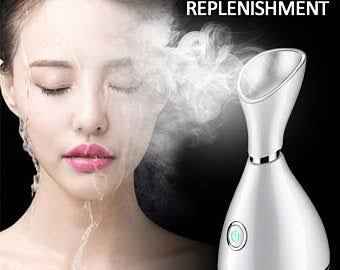
As you have seen above, a dirty humidifier will cause humidifier sickness symptoms. Therefore, you need to know how to keep it clean and bacteria-free.
Follow these tips:
Daily cleaning
This can help with the humidifier dangers.
Clean the unit every day and not later than three days, using warm water and dish soap. Scrub the reservoir to remove deposits or scale. Avoid using disinfectants since they cause more problems, such as lung injuries.
If you use disinfectants such as chlorine bleach, rinse the tank thoroughly so that you don’t end up inhaling harmful chemicals.
Alternatively, you could use white vinegar, which is safer as a disinfectant.
Remember to NEVER USE WHITE VINEGAR AND BLEACH TOGETHER!
Replace the water daily
Empty the reservoir, dry it, and refill the water. This will prevent the growth of fungus and bacteria since they need stagnant water to thrive.
It will prevent mineral deposits and film from developing. This is more important for ultrasonic and cool-mist humidifiers.
Only fill the tank with demineralized or distilled water. You should not use tap water because it may contain minerals that become white dust when released into the air.
Monitor the humidity level in your home. You can use a hygrometer. The recommended humidity level is 50% or below. Too much moisture in the air can make your home a breeding ground for spores and mold.
Replace the filters at least every two months or as recommended by the manufacturer.
Clean the area where you keep the humidifier
The area around humidifiers should remain dry. If you see any wetness such as on the wall, table, windows, or carpets, reduce the frequency of use or turn it down. Damp places can be breeding points for mold and fungus.
Clean your unit even when not in use
Clean and dry the unit before storage and after removing it from storage. If you store a dirty and wet unit, you are giving the microorganisms time and a place to multiply.
These will affect your family when you start using it again. Clean it after storage to get rid of any harmful microorganisms that may have been harbored in it.
Humidifier Sickness Symptoms FAQ
It can be disheartening that an appliance designed to keep you safe can cause illness. But when water stays for long in closed spaces, protozoans, sometimes unidentifiable, can grow.
They will then be dispersed, like tiny droplets of water (mist), into your space. To help you understand this better, here are the more frequently asked questions:
How long does humidifier sickness last?
People also ask: How long does humidifier lung last? 2 to 4 days. This should last just a short period, or, at worst, less than a week. Unless your immunity is compromised, humidifier fever will not get you laid up at home, so you can still attend school or work as you recover.
The good thing about humidifier fever is that it goes away on its own as soon as you are no longer exposed to the agents that cause it. Therefore, once you clean and sterilize the humidifier, you will be healed in a few days.
What is humidifier fever?
Also called hypersensitivity pneumonitis, this is a kind of lung fever that affects you when you inhale air that is contaminated with some bacteria variants.
Some of the common humidifier fever symptoms include lung inflammation, coughs, fever, body aches, chills, and shortness of breath. These should go away after a few days when you clean your humidifier
Is humidifier fever contagious?
In most cases, humidifier lung is not contagious. It only happens when a person inhales the infected air, but it rarely passes from one person to another.
If the humidifier is not cleaned with bleach to kill the causative agents, continuous exposure might cause an immunity compromise, in which case a person might catch other contagious illnesses.
Does humidifier fever go away on its own?
Once you clean the humidifier and kill the mold spores and bacteria, the symptoms of the humidifier lung start to go away. They will disappear on their own after two days.
Can you get sick from a cool mist humidifier?
You can if you do not clean it. Any humidifier that you do not clean can allow bacteria to grow in the tank. It will then disperse these with the mist, and you will inhale them and get humidifier fever. Such can also cause a musty smell.
What are the side effects of a humidifier?
There are several, but the most common of them include humidifier sickness if you do not clean your unit. Too much humidity can also cause allergy flare-ups and runny noses.
Your unit can also cause the growth of mold, which can damage your leather items, clothes, and walls and make you sick.
How do you treat humidifier sickness?
If you clean your humidifier regularly, the symptoms of humidifier sickness will disappear on their own in two to five days.
To kill protozoans that cause diseases, clean them with white vinegar, hydrogen peroxide, or bleach. Remember, you should never mix bleach and vinegar, as they form a poisonous gas.
How do I get rid of my humidifier sickness?

Now that we know there is a bad side to humidifiers, you need to seek humidifier sickness treatment. This will be based on the symptoms of sickness you have been experiencing.
Secondly, you need to make sure that the sickness does not occur again. To prevent this, you need to clean to stay on the lookout for mold in the unit.
Pink mold in the humidifier, black, gray, or green mold, means you have neglected the maintenance of your humidifier.
If you use your humidifier daily, you should clean it daily. Okay, you might not need to clean it in its entirety, you know, including the base, but clean the tank with white vinegar. This will kill any microbes.
Check that the humidifier is not releasing too much mist to over-humidify your air. Too much humidity can also make you sick!
Remember, most portable humidifiers don’t have an automatic shut-off option when the right humidity is reached. Humidifiers shut down when they run out of water.
Use clean, mineral-free water in your humidifier. If you use tap water, the minerals will clog the filter.
The filter will not work properly, and many microbes will be pumped out with the mist. These microbes make you sick!
If you have to change water daily and buying distilled water seems like too much, you can use a demineralization cartridge to remove minerals from tap water.
Why does my humidifier make me sick?
The main reason your Pure Enrichment humidifier or Levoit humidifier is making you sick is neglect.
It is dirty. Perhaps it is very dirty!
Therefore, refer to the instructions for how to clean the Crane humidifier or any humidifier that you may have at home.
Whatever is in the tank of the humidifier, if it is small enough, will be pumped out with the mist. And your family will inhale it.
If there is mold, inhaling it can cause mold toxicity symptoms. If there are bacteria, you will inhale them too.
A humidifier can also make you sick if it is too large for the space, therefore over-humidifying the room. You could start experiencing the effects of high humidity on the body.
Can a humidifier cause a stuffy nose?

A humidifier can cause a stuffy nose when, again, you fail to maintain it properly. If you inhale microbes, mold, and other fungi that might be in the tank, they will make you sick.
All of these things can cause inflammation of your nasal membranes, and this will make you feel congested. A humidifier can cause chest tightness too.
Exposure to too much humidity can also cause a stuffy nose. Therefore, keep an eye on the hygrometer so that you can switch the humidifier off as soon as the right humidity level is reached.
Can sleeping with a humidifier make you congested?
What to do if your humidifier makes you sick

If you have established that your humidifier makes you sick, well, you are going to need to do the following:
Clean the humidifier
Stagnant water is good for breeding germs. That is why you must remove the water daily and replace it with clean water. Boiled water in the humidifier is not going to do much good.
Also, you might add a dash of essential oil to the humidifier. However, do not overdo it because many of these units are not designed to diffuse essential oils.
Essential oils help with congestion. They also help you to relax and reduce your anxiety and stress. If aromatherapy is your thing, consider getting a Vicks Humidifier with Vapopads.
Use the right cleaning products: mild soap and warm water. You can also use white vinegar to kill bacteria. However, do not use chemicals such as bleach.
Also, do not add water softeners to the humidifier.
Change the filters as needed
Humidifiers have HEPA filters to remove bacteria, fungi, and viruses from the water. That way, the mist getting into your air is clean.
However, with time, the filters become clogged up with so many contaminants. They start leaking into your mist, and when you inhale it, they get into your body and cause illness.
Check with the manufacturer to know how often you should replace the filters. Also, a humidifier with washable filters helps a lot. You can clean them often to keep your mist pure.
Use distilled water only
When you use tap water, the minerals will dissolve, and they will be pumped out in the mist. Inhaling these minerals can cause inflammation of your airways.
If you cannot afford distilled water daily, filter the tap water you have at home. You can do this using a filtration system. You can also use a demineralization cartridge.
Another option is to use humidifier tablets. These form ions that bond with the minerals in the water. The minerals are captured on the filters, and the pure mist is released into your indoor air.
Visit a doctor
Never attribute all the humidifier sickness symptoms to… well, humidifiers! They could be an indication of a bigger underlying issue.
Visit a doctor to find out what you could be suffering from and the root cause. In addition, some of these illnesses require treatment with medicine.
If the doctor recommends lowering the humidity level some more, make the changes!
Final Thoughts on Humidifier Sickness Symptoms
Humidifiers may change their role from that of preventing illness to that of causing it. If they are not cleaned and maintained correctly, they can cause respiratory diseases.
These include coughs and colds, flu, allergic reactions, and lung infections. Stay alert for any of the humidifier sickness symptoms.
However, this need not happen. It is possible to use a humidifier and not get sick. Start by cleaning the unit properly, using distilled water, replacing filters, and replacing the water daily.
You can get a good humidifier such as GENIANI Portable Mini Humidifier on amazon.com. It is easy to maintain, and it is very effective.
